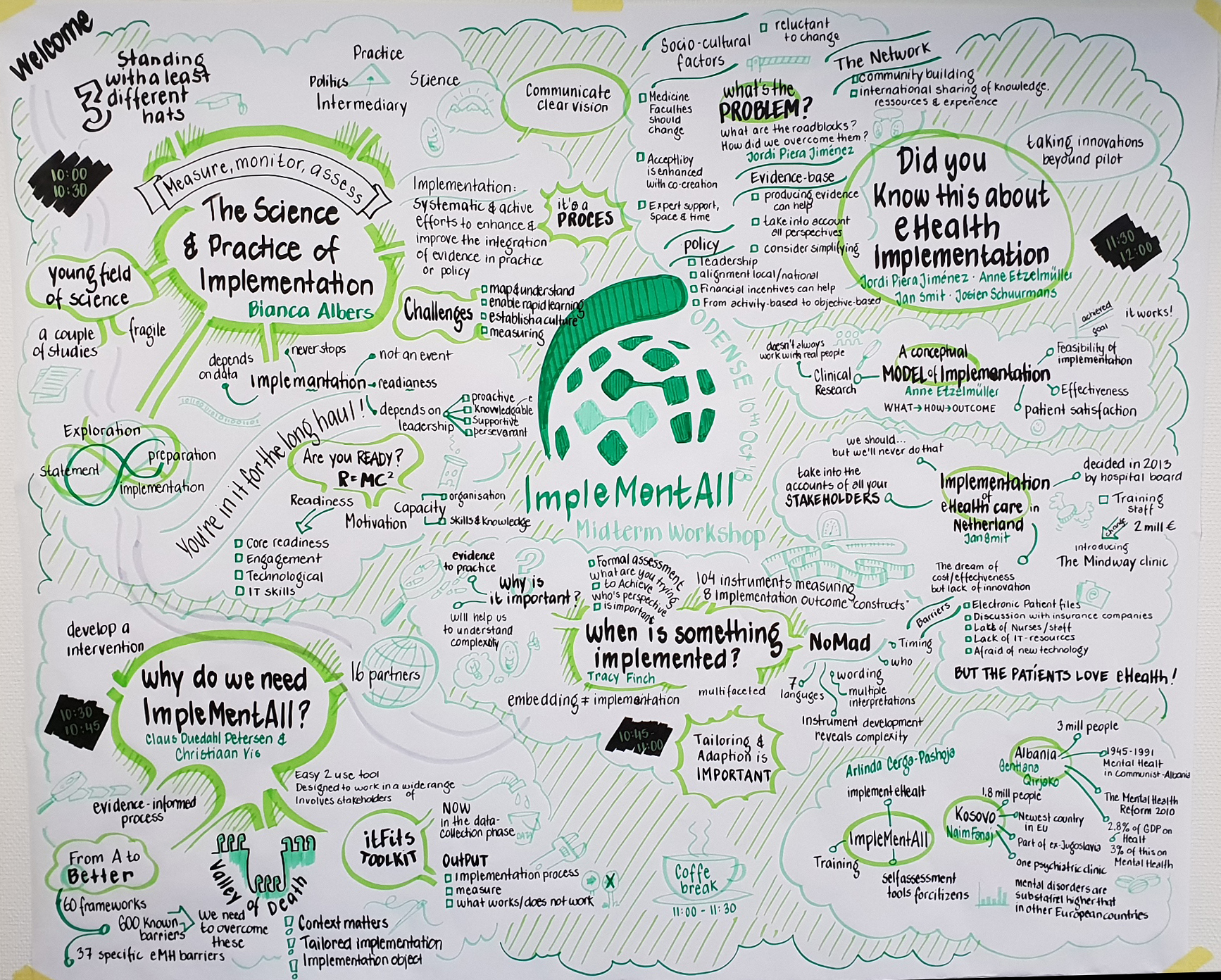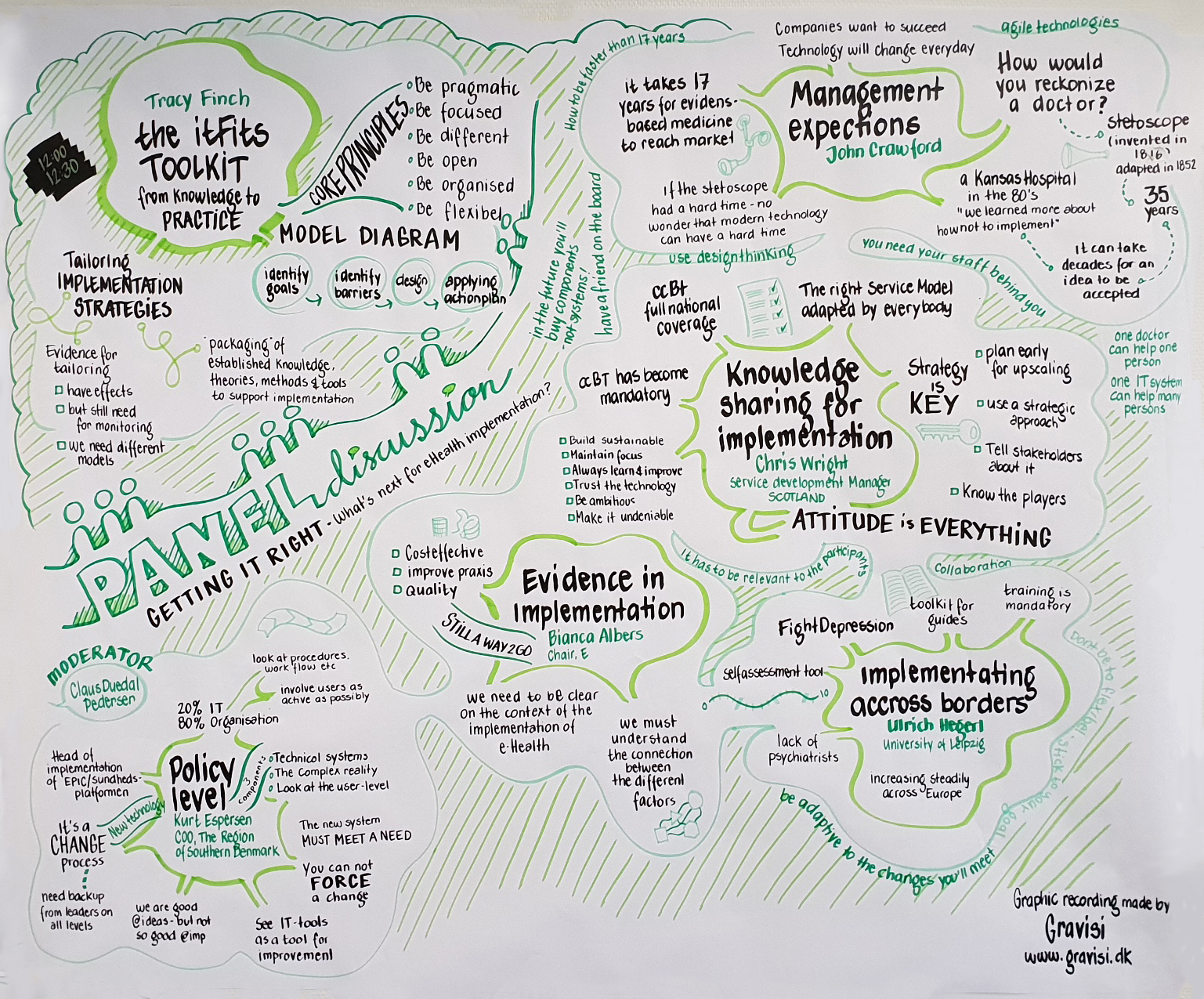Outcomes and resources
This page contains all public deliverables, papers, and any other materials describing our outcomes as they are produced and published.
Navigation
![]() ItFits-toolkit resources
ItFits-toolkit resources![]() Deliverables
Deliverables![]() Presentations from the Final Conference
Presentations from the Final Conference![]() NoMAD translations
NoMAD translations![]() ORIC translations
ORIC translations![]() Other Outcomes
Other Outcomes
ItFits-toolkit resources
ItFits-toolkit introduction video
Deliverables
![]() D1.1 Repository of determinants of practice and implementation interventions
D1.1 Repository of determinants of practice and implementation interventions
![]() D1.3 Integrated Implementation Framework the ItFits-toolkit
D1.3 Integrated Implementation Framework the ItFits-toolkit
![]() D5.2 Final implementation and knowledge exchange report
D5.2 Final implementation and knowledge exchange report
![]() D6.1 Stakeholder analysis and advisory board plan
D6.1 Stakeholder analysis and advisory board plan
![]() D6.2 Stakeholders Advisory Board activities
D6.2 Stakeholders Advisory Board activities
![]() D7.3 Report on liaison activities
D7.3 Report on liaison activities
![]() D7.4 Final report on dissemination activities
D7.4 Final report on dissemination activities
Presentations from the Final Conference
Christiaan Vis - Effectiveness of the ItFits Toolkit
Dr. Robin Kenter - CMMH Norway
Erik Van der Eycken - Implement(ed) All(most) for patients?
Jinane Abi Ramia & Dr. Ken Carswell - Step-by-Step in Lebanon
Johanna Freund, Flashtalk - Digital Prevention of Depression for Farmers?
Nicholas Watters - e-Mental Health: Innovation to Implementation
Prof. Tracy Finch - ItFits-toolkit Process Evaluation
NoMAD translations
The NoMAD instrument is designed to help researchers and practitioners get a better understanding of how to implement new technologies and complex interventions in healthcare. It is a measure that can be applied to assess, monitor, or measure factors likely to affect normalisation from the perspective of implementation participants. The instrument is used in the context of the ImpleMentAll study and is therefore translated into seven different languages used all over Europe and Australia.
What can you use the NoMAD for?
Like in ImpleMentAll, we hope that the NoMAD instrument will be used for a wide range of implementation purposes and across different settings. It could be used simply to describe participants’ views about how a healthcare innovation impacts on their work, and how others involved in implementation work are engaging with it. It could be used at different time points, to see if perceptions have changed after a period time. It can also be used for improving implementation processes by identifying areas needing further work to progress an implementation project.
How to use the NoMAD questionnaire?
Whatever way you wish to use the NoMAD instrument, this will determine how you approach the task of customising your survey. The questionnaire may be used in different ways to suit your needs but it needs to be adapted to ‘make sense’ for your participants. Here we provide guidance on how to adapt and/or translate the NoMAD questionnaire to fit your specific purposes.
Customising NoMAD for use
The NoMAD instrument items need to be embedded in a survey that you develop yourself so that it is appropriate for your target respondents. This includes having a specific introduction about the intervention you are implementing, adding relevant questions about the respondents’ roles, and potentially including additional general questions about the intervention that you are also interested in.
-
1. Determine who should complete the survey
You may be interested in the perceptions of a single group of professionals, or multiple groups. In deciding who should complete it, a key consideration is how involved they are with the implementation. It is likely that some groups will be more familiar with engaging with the target intervention than are others, but this is okay if all groups are familiar enough to be able to answer most questions.
-
2. Deciding how to conduct the survey
It is possible to create your survey electronically (e.g. using online survey software) or on paper. This will depend on how you can best access respondents. Keep in mind that the way you collect your data might influence the reliability of it. In the ImpleMentAll study, we used the electronical approach.
-
3. Customising the instructions
An example of a customised introduction of the survey can be found here. This just needs to be adapted to fit your own purpose.
-
4. Determine your role questions
These questions should reflect your participant groups and any other information you might want to collect for comparing responses. For example, if you are surveying people from different sites or geographical regions and want to explore any site differences, then you will include a question about this.
-
5. Customising the wording of the items
We recommend that throughout the survey, the term [the intervention] is replaced with an intervention ‘name’ you are using within your study.
-
6. Analysing your survey data
How you approach this will depend on the questions you wish to explore, and the expertise you have available for analysis. However, we believe that this does not need to be complicated. For example, tables summarising the frequency of responses to items can indicate where participants are providing more positive or negative responses.
-
7. Linking responses of individuals at different survey points
If you are interested in how individuals' perceptions change over time, you may wish to repeat your measure. Make sure that you are tracking individual responses by using unique identifiers.
How to cite the NoMAD instrument
Normalization Measure Development Questionnaire (NoMAD), (2018, October 16). Retrieved from http://www.implementall.eu/
Further information
More information regarding the background and development of the instrument can be found here. Psychometric studies of the NoMAD questionnaire will be presented here as well.
Translated versions
The NoMAD questionnaire is translated to seven languages within the ImpleMentAll consortium. Translated versions are available for free as well as information about the translation procedure applied (see below). When using the NoMAD questionnaire, please include the following copyright statement in the questionnaire materials and the reporting: © 2018 by the ImpleMentAll partners. NoMAD is licensed under a Creative Commons Attribution-NonCommercial 4.0 International License.
Albanian Danish Dutch English French German Italian Spanish Norwegian
The Norwegian translation is not part of the ImpleMentAll project, but stems from our network and followed a similar translation procedure (from Danish to Norwegian).
Translation guide
This translation guide was used to translate the NoMAD questionnaire to the different target languages within the ImpleMentAll study. The guide is of highly practical nature due to the ImpleMentAll study setting. In case you decide to use the NoMAD questionnaire for your purposes and to translate it into your target language, we recommend you to follow the translation guide in order to ensure quality standards of your translation. We are happy to share our experiences when you plan to translate the NoMAD into a new language, please contact us here or via the contact form on this website.
ORIC translations
In the ImpleMentAll project, we use the Organizational Readiness for Implementing Change questionnaire (ORIC), developed by Christopher Shea and colleagues (2014), as an outcome measure assessed in our twelve partner sites. The ORIC questionnaire is translated to seven languages within the ImpleMentAll consortium. Translated versions are available for free as well as information about the translation procedure applied. In the questionnaire file itself, you can find further notes on how to cite and apply the ORIC instrument.
Albanian Danish Dutch English French German Italian Spanish
Other Outcomes
Midterm Workshop graphic recording
The presentations and discussions from our Midterm Workshop (Odense, 10 October 2018) are summed up in the below graphic recording. For more information about the workshop and access to the presentations, click here.



